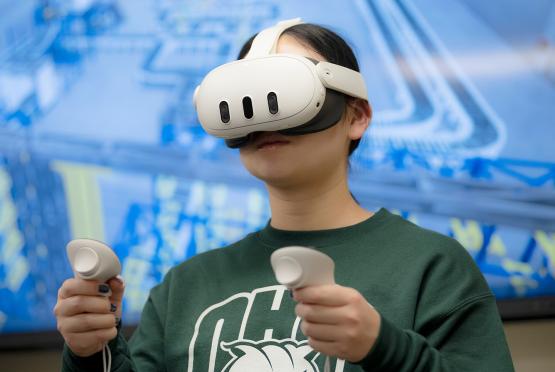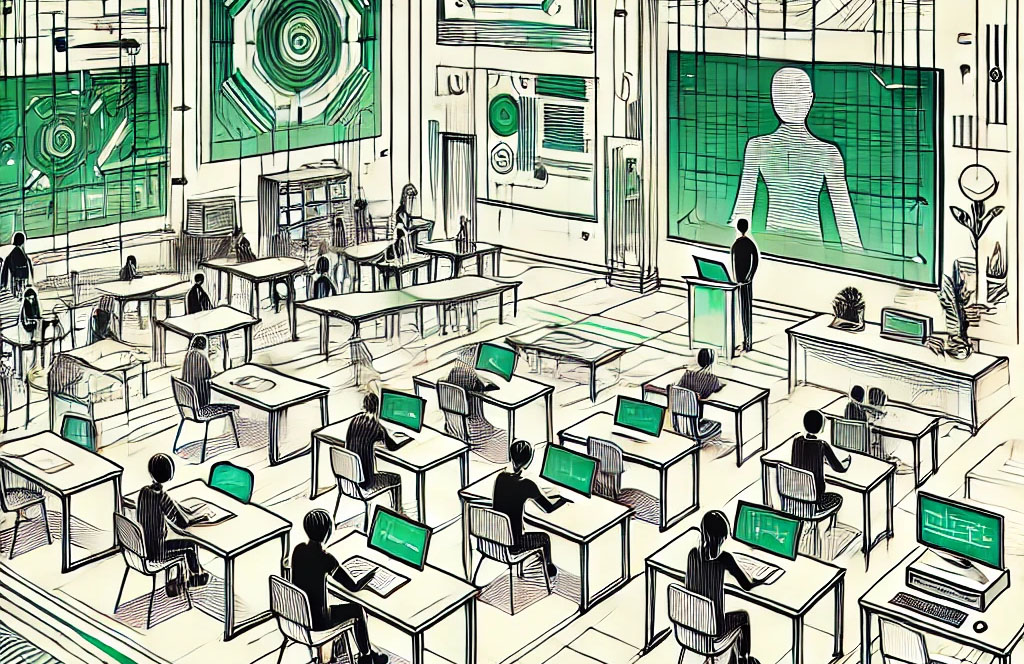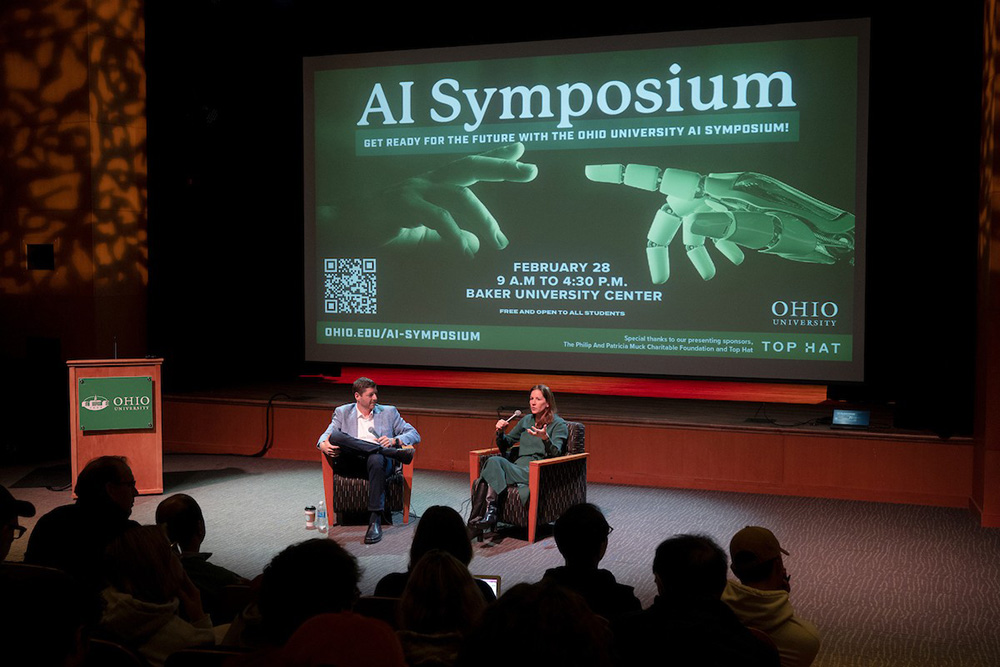
Determining if content is human or AI-generated is harder than it seems, especially as the software is becoming more sophisticated. Inside Higher Ed declares reading all but dead, noting that today’s students prefer to summarize reading assignments using ChatGTP versus diving into a textbook.
It’s not all doom and gloom, though – from helping to create personalized learning plans to aiding in understanding a challenging concept, AI is transforming the way we teach and learn. But with this transformation comes a host of challenges and opportunities that educators must navigate. At Ohio University, professors and GenAI experts aren’t just weighing in on AI policy, they’re embracing AI by establishing a path to success for students and other college educators around the country.
Navigating AI’s challenges and opportunities in college classrooms
The speed at which AI has advanced is unprecedented. New tools and applications emerge almost daily, forcing educators to rethink their teaching practices. And while some are quickly finding their niche within AI, many educators are still struggling to effectively incorporate GenAI into their curriculum or ensure it’s not being used to avoid answering complex reasoning questions or writing essays.
But with the rapid improvements developers continue to make, detecting AI within a student’s answers is increasingly difficult and nearly impossible to prevent.

Shifting from AI detection to AI-driven critical thinking
“The focus must shift from preventing the use of GenAI to designing [curriculum for] its use,” says Vic Matta, an associate professor in the College of Business at Ohio University whose research includes technology adoption and consumer behavior.
Matta shared what he believes are key two changes necessary in education’s existing conventions.
“One is to educate about its use (prompt engineering and reliability of responses). The second is to design our curriculum to emphasize critical thinking and problem-solving skills.”
A recent article published in The Atlantic stated more than 70 percent of higher-ed instructors who regularly use GenAI were using it to grade student work.
OHIO hosted an AI symposium in February with industry experts sharing their views on what’s next, and what to watch out for.
“You are entering maybe the weirdest timeline in human history.... You’re going into this phase where all of this is new and being reinvented. That's actually an opportunity," said Paul Roetzer, founder and CEO of Marketing AI Institute, in the symposium keynote.
Creating personalized learning with AI: Ohio University's approach
Traditional education approaches are now being reassessed as educators develop new strategies to evaluate students' ability to think critically, analyze information, and apply AI tools appropriately. Paul Shovlin, assistant professor of English and Faculty Fellow for the Center for Teaching, Learning and Assessment (CTLA) shared his thoughts regarding the opportunity for more personalized learning using GenAI.
“Generative AI can be used to personalize learning in a number of ways," Shovlin said. "Students can use it to create quizzes related to topics of study. They can ask a Language Learning Model (LLM) like ChatGPT to ask them questions, give them feedback on their answers, and make suggestions for improved responses.”
With AI being used to create tailored learning experiences that cater to individual students' needs and learning styles, educators could even see improved engagement and outcomes. But it’s still relatively early days, with most professors still unsure how to proceed. A Tyton Partners report in October of 2023 found only 22 percent of faculty members were incorporating AI.
Balancing AI reliance: Avoiding the pitfalls of overuse
Beyond the use cases, questions linger around data ownership as well as AI’s using their own training data to generate responses. Chad Mourning, assistant professor and principal investigator on the Low Altitude Weather Network, which uses machine learning, understands the challenges of using AI as a source for accurate information.
“The quality of most machine learning models is driven by the quality of their training data. There are several court cases about possible misappropriation of copyrighted material in the popular large language and multi-modal models, such as transcripts of YouTube videos,” Mourning said.
He added that there are also challenges associated with increased reliance on AI.
“It's human nature to take the path of least resistance, which right now is often AI. We are in this awkward, liminal space where off-the-shelf Large Language Models are better than the average first-year student or sophomore [at generating written content or source code for programming assignments], but worse than what we expect out of our graduating seniors, so you end up with students in their last couple of years that haven't actually learned anything. Maybe it's AI, maybe it's lasting effects of COVID lockdowns, but I'm failing more seniors than I used to.”
But beyond the problem of students relying too heavily on AI, Mourning also notes the growing concern regarding “dead internet theory.”
“An over-reliance on AI could also be problematic if we have an ‘AI collapse,’ where the models start getting worse because too much AI-generated data makes its way into the training data,” Mourning stated.
Preparing students for careers with AI: Ohio University’s path forward
Despite educators and institutions scrambling to establish policy around curriculum-driven GenAI, there is reason for optimism. Ohio University recently announced a new bachelor’s degree in Artificial Intelligence. OHIO’s CTLA has allowed educators to proactively create protocols for teaching alongside GenAI tools, giving Bobcats new opportunities to not only leverage GenAI in their studies, but prepare for a career centered around AI and its growing business use cases. OHIO faculty have access to training through the Fall 2024 AI-enhanced Course Redesign Institute.
The redesign institute is facilitated by CTLA AI faculty fellows Shovlin, assistant professor of English, and Jared DeForest, professor and chair of the department of Environmental and Plant Biology, supported by staff from the CTLA, the Office of Instructional Design and the Office of Information Technology. A stipend following completion will be provided. Both Shovlin and DeForest have extensively redesigned courses in response to GenAI developments.
“We need to provide better rationales to our students for the value of our courses’ learning objectives with explanations of how using GenAI could support or detract from achieving those objectives,” Shovlin said.

Paul Roetzer '00, founder and CEO of Marketing AI Institute, and Natalie Zmuda '02, Amazon's Director of Conversational Shopping and Editor-in-Chief of Shopping AI, speak on stage at the Ohio University AI Symposium in February 2024.
The path to a sustainable educational environment alongside AI starts with literacy, implementing new assessment methods, promoting equity and access, and fostering professional development.
By addressing these challenges and seizing the opportunities presented by AI, educators can ensure higher education remains relevant and effective in the digital age. If the future of education is being shaped by AI, it will be up to educators to embrace this new reality and adapt their teaching practices accordingly.
When asked how to ensure AI is used to enhance human potential rather than replace it, Shovlin shared his final thoughts.
“The best strategy is for more concerned practitioners to educate themselves on best practices and ethical considerations related to GenAI in higher educational settings,” he said. “We need more people to be present and knowledgeable in discussions regarding GenAI's proliferation in higher education. It's a responsibility that all stakeholders should share.”



